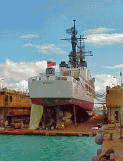Input/Output, Hydrostatics for One Waterline (English
Units)
Description:
This spreadsheet
automatically computes hydrostatics characteristics for
one waterline. If the waterline is level this data may be used as an
input source for the vessel's "Curves of Form."
Though optional, this spreadsheet is best utilized in
conjunction with a Displacement Sheet (Product
Disp-e) and a
Waterplane Sheet (Product
WP-e). A
further enhancement is combining this sheet with a Displacement sheet and
a Waterplane sheet. In fact a product is available that combines all
these sheets together, it is called Waterline Hydrostatics Data Sheet
(Product
WL-hydro-e). This combination facilitates faster and easier
computation for a given waterline. In the combined case calculations
are more automated, significantly minimizing entry input time.
Electronic
Document Type: Microsoft Excel
spreadsheet
Cost:
Free
Number of
Pages: single sheet
Inputs:
- Items related to half breadth inputs:
-
Enter in
the waterplane area (AWP), longitudinal center of floatation
(LCF), longitudinal moment of inertia (ILCF) and transverse
moments of inertia (IT). This data is
normally obtained from a waterplane sheet which involves half beam
characteristics. Hawaii Marine's waterplane sheet, product
WP-e, would work
here. Alternatively calculative results obtained by hand
calculations, CAD output, planimeter or some another source may inserted here.
Optional Input Items:
Outputs:
The
automatic output generated are the tons per Inch (TPI),
longitudinal metacentric radius (BML), transverse metacentric
radius (BMT), distance from keel to longitudinal metacenter
(KML),
distance from keel to transverse metacenter (KMT), bock
coefficient (CB), prismatic coefficient (CP), and miship's
coefficient (CM).
Suggested
Reading (see
References page for
more detail on these items):
Microsoft Excel user manuals
Principles of Naval Architecture, Edward V. Lewis, SNAME
Basic Ship Theory, Rawson & Tupper
Applied Naval Architecture, Robert B. Zubaly
Introduction to Naval Architecture, E. C. Tupper
Introduction to Naval Architecture, Thomas Gillmer and
Bruce Johnson
Terms:
Prior to purchase, read our
End User License Terms.
Download Now:
Click one of the following buttons to pay.
After payment you will be taken directly to the download page.
Download Now: Click the following link to download the
free template.
Free Download
Minimum System Requirements: Windows 95/98/NT/2000/XP/Vista/Windows7
Sample:
A sample document is shown below.

|



